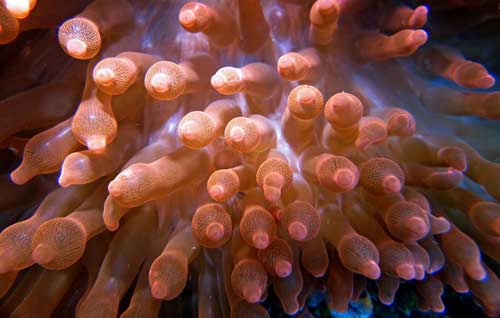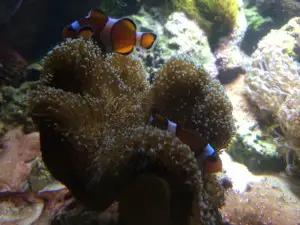The common clownfish is probably the single-most popular saltwater aquarium fish out there–ever. There is just some universal appeal about the bright orange color with white and black stripes that captivates the human mind.

I know that was one of the first fish I had to have, and I suspect it may have been one of your first fish as well. If you’re like me, you probably also imagined yourself keeping the clownfish with a host anemone.
Do clownfish need anemones?
In the wild, clownfishes are found almost exclusively within reach of their host anemone (except when they are swimming out to touch the ‘butt’ like in Finding Nemo). In a home aquarium, clownfish do not need anemones and it is probably best if you don’t even try to keep them with an anemone.
Clownfishes generally take to aquarium life like a fish takes to water, most species of anemone do quite poorly (and mostly die) in aquarium conditions.
According to a survey in Wilkerson’s book about Clownfish (admittedly dated), less than 1 in 18 anemones survived in captivity for 3 years and 1 in 36 made it to 5 years in captivity. To make a fantastic understatement, that’s pretty bad.
A great place to learn more about Clownfishes and their commensal relationship with anemones is the book, Clownfishes, by Joyce D. Wilkerson, if you are lucky enough to score a used copy somewhere (I don’t think it is still in print).
The good news is that clownfish do not need a host anemone to be happy and healthy in your saltwater aquarium. They will do quite fine without one. If you’re lucky, they may even take up residence in a surrogate. The clownfish in my tank recently took up residence in a toadstool leather coral (sarcophyton species) in the front of the tank. I have to admit, it’s a pretty cool sight to see.
If you MUST have an anemone, ask your local fish store for an aquacultured (if possible) bubble tip anemone. These anemones are hardier than the average anemone and look amazing. They are available in different shades of color that blend green and red.

Beware, though, that anemones have a bad habit of moving around your tank. You might be thinking…” yeah, so what?” The so what is that they can burn a hole of destruction along the way, stinging everything in reach and often end up sucked into a powerhead. I don’t mean to be so down on anemones, I just want to be real about all the challenges with keeping them healthy.
Why don’t clownfish get stung by anemones?
Apparently, the jury is still out on that question.
According to the AskNature.org website, clownfishes are protected by their mucous coat and get a little anemone mucus mixed in each time–eventually fooling the anemone into not detecting the clownfish at all.
According to wiki answers, the secret lies within the actual makeup of the mucus–and that clownfish lack the substance in ‘normal’ mucus that triggers the stinging response.
A third site reports that there is no consensus and that it could be either (or both).
Personally, I think it’s because anemones have a good sense of humor. What do you think?



Leave a Reply